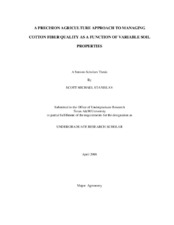| dc.description.abstract | Cotton producers can maximize yield and fiber quality by understanding soil variability
throughout the fields, thus receiving premium prices for the cotton lint. A better
understanding of how soil water holding capacity affects cotton lint yield and quality can
result in improved management practices that can maximize fiber quality while
minimizing inputs. The objectives of this study were to 1) create management zones
using a soil ECa map, 2) test the usefulness of this map using measurements of lint
quality and lint quantity in both irrigated and dryland fields, and 3) determine a
relationship between soil water holding capacity fiber quality parameters.
The selected site was Texas A&M University s IMPACT center which is located nine
miles west of College Station, TX in the Brazos River floodplain. In the 2006 and 2007
growing seasons, 24 measurement locations were selected in a dryland and irrigated
cotton field, 12 locations in each field. The sites were selected using a map of soil ECa,
three ECa categories and four replications. At each location soil texture, soil water
holding capacity, and lint quality (HVI) and quantity were measured. The ECa categories
successfully identified significant differences in clay content water holding capacity, lint
yield, lint quality, and loan values. The 2006 season was relatively dry. Weather, soil
variability, and management affected the yield and yield quality responses. Water
availability was not a factor for lint yield or quality in 2007. In this situation, the soil was
the primary factor for field heterogeneity. The cotton yield still responded to soil
variability but lint quality and loan value was uniform. The uniformity of lint quality
and non-uniformity of lint quantity leads to the conclusion that these soils have
individual yield thresholds, but without water stress the quality threshold is uniform.
This conclusion illuminates opportunities for precision management strategies. One
management strategy that may result from this work is to reduce seeding rates in lower
production areas of the field, if the plants will compensate for yield to still reach the
soils yield potential, perhaps less competition for water would improve lint quality. | en |


